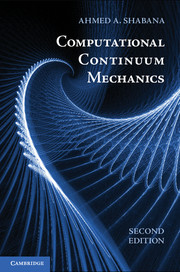Book contents
- Frontmatter
- Contents
- Preface
- 1 Introduction
- 2 Kinematics
- 3 Forces and Stresses
- 4 Constitutive Equations
- 5 Plasticity Formulations
- 6 Finite Element Formulation: Large-Deformation, Large-Rotation Problem
- 7 Finite Element Formulation: Small-Deformation, Large-Rotation Problem
- 8 Computational Geometry and Finite Element Analysis
- References
- Index
2 - Kinematics
Published online by Cambridge University Press: 05 June 2012
- Frontmatter
- Contents
- Preface
- 1 Introduction
- 2 Kinematics
- 3 Forces and Stresses
- 4 Constitutive Equations
- 5 Plasticity Formulations
- 6 Finite Element Formulation: Large-Deformation, Large-Rotation Problem
- 7 Finite Element Formulation: Small-Deformation, Large-Rotation Problem
- 8 Computational Geometry and Finite Element Analysis
- References
- Index
Summary
In this chapter, the general kinematic equations for the continuum are developed. The kinematic analysis presented in this chapter is purely geometric and does not involve any force analysis. The continuum is assumed to undergo an arbitrary displacement and no simplifying assumptions are made except when special cases are discussed. Recall that in the special case of an unconstrained three-dimensional rigid-body motion, six independent coordinates are required in order to describe arbitrary rigid-body translation and rotation displacements. The general displacement of an infinitesimal material volume on a deformable body, on the other hand, can be described in terms of twelve independent variables; three translation parameters, three rigid-body rotation parameters, and six deformation parameters. One can visualize these modes of displacements by considering a cube that may undergo an arbitrary displacement. The cube can be translated in three independent orthogonal directions (translation degrees of freedom), it can be rotated as a rigid body about three orthogonal axes, and it can experience six independent modes of deformation. These deformation modes are elongations or contractions in three different directions and three shear deformation modes. It is shown in this chapter that the rotations and the deformations can be completely described using the matrix of the position vector gradients, which in general has nine independent elements. This fact can be mathematically proven using the polar decomposition theorem discussed in the preceding chapter. The deformation at the material points on the body can be described in terms of six independent strain components. These strain components can be defined in the undeformed reference configuration leading to the Green–Lagrange strains or can be defined using the current deformed configuration leading to the Eulerian or Almansi strains. The velocity gradients and the rate of deformation tensor also play a fundamental role in the theory of nonlinear continuum mechanics and for this reason they are discussed in detail in this chapter. The concept of objectivity or frame indifference, which is important in the analysis of large deformations, particularly in formulations that involve the strain rates, is also introduced and will be discussed in more detail in the following chapter of this book. In order to correctly formulate the dynamic equations of the continuum, one needs to develop the relationships between the volume and area of the body in the reference configuration and its volume and area in the current configuration. These relationships as well as the continuity equation derived from the conservation of mass are presented in Section 8 and Section 9 of this chapter. Reynold’s transport theorem, which is used in fluid mechanics, is discussed in Section 10. In Section 11, several examples of simple deformations are presented.
- Type
- Chapter
- Information
- Computational Continuum Mechanics , pp. 46 - 96Publisher: Cambridge University PressPrint publication year: 2011

